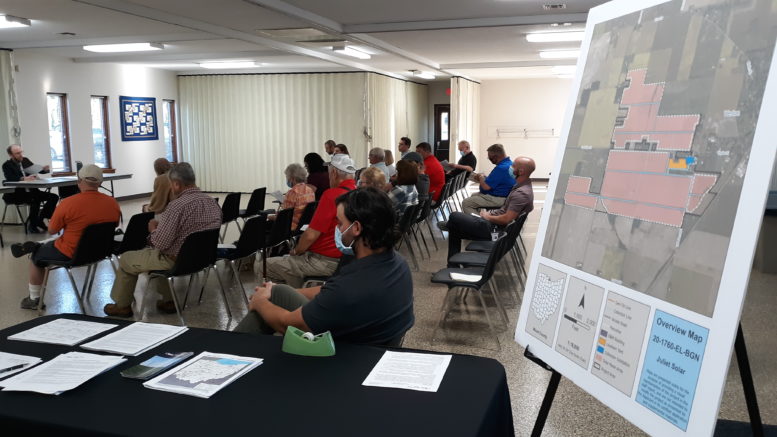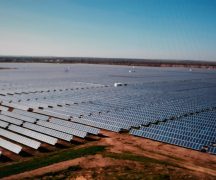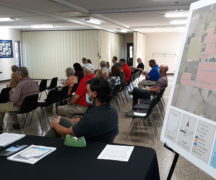By JAN LARSON McLAUGHLIN
BG Independent News
The massive solar field planned near Weston received a green light Thursday from the Ohio Power Siting Board.
The 101 megawatt Juliet Energy Project will be located on approximately 585 acres of an approximately 670-acre project area in Weston and Milton townships. The proposed solar farm is five times the size of Bowling Green’s solar field northeast of the city.
In September, members of the Ohio Power Siting Board listened as people testified about the economic and energy benefits of the solar field, the loss of prime farmland, and the harm it will cause the homes swallowed up by the site.
A total 30 residential properties will be affected by the proposed Juliet Solar Farm, which will touch homes on Sand Ridge, Weston and Milton roads. Some residential properties along Sand Ridge Road will be surrounded by solar panels on all four sides since the proposed solar farm stretches on both sides of the road.
Speaking in favor of the solar project in September were representatives of Local 18 Operating Engineers, and the Toledo Chamber of Commerce. Brian Dicken, of the chamber, said the solar field will contribute to the energy resilience of the region, create about 200 construction jobs, and bring in $800,000 annually in tax revenue for schools, the townships and village.
Weston Mayor Jeremy Schroeder talked about the village benefitting from the solar field tax revenue.
“There are only a handful of opportunities for growth” in a small village, without taxing residents, Schroeder said.
“Development spurs growth, and I’m in favor of that,” he said.
The solar field would mean a loss of corn and soybean fields, but “it will be used to farm sunlight,” Schroeder said.
But some neighbors voiced strong objections to the solar project.
Alina Hass, of Weston Road, questioned the accuracy of the promises made by the solar firm.
“Solar projects present an intoxicating opportunity,” she said. But they “have a very long history of failure.”
Haas talked about the unexpected consequences of the solar project, the lack of sunshine in Ohio, and the highly subsidized nature of solar energy.
“So when they fail, they also fail the taxpayers,” she said.
“We don’t have the benefit of falling back on the promises that were made,” Haas added.
Her husband, Bradley Haas, said the solar project “comes up to our backdoor.”
As a farmer, Haas said the loss of prime farmland is troubling.
“I’m not too excited about land being covered up with solar panels,” he said.
“This is going to be covering up some of the best ground in Weston Township,” Bradley Haas said, comparing it to replacing nice suburban homes with low income apartments.
The Ohio Power Siting Board staff conducted an investigation of the Juliet Energy Solar project application and prepared a report making recommendations to the OPSB members. The staff recommended that construction of the solar farm be subject to 30 conditions, including requiring Juliet Energy Solar to:
- Prepare a landscape and lighting plan addressing aesthetic and lighting impacts where an adjacent non-participating parcel contains a residence with a direct line of sight to the facility.
- General construction activities shall be limited to the hours of 7 a.m. to 7 p.m., or dusk when sunset occurs after 7 p.m.
- Have an environmental specialist on site during construction activities that may affect sensitive areas such as wetland and streams, and potential threatened or endangered species.
- Implement a complaint resolution process to address potential complaints resulting from facility construction and operation, and provide a total decommissioning plan and cost estimate.
- Install a perimeter fence type that is both wildlife permeable and aesthetically fitting for a rural location and prevent the establishment of noxious weeds, and if found to be present, remove and treat them with herbicides as necessary.
- Avoid or minimize damage to functioning field tile drainage systems and agricultural soils and promptly repair damaged field tile systems to at least original conditions or modern equivalent.
- Submit an updated decommissioning plan and total decommissioning cost estimate without regard to salvage value.



